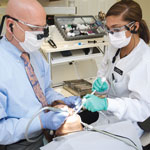
GET OUT OF YOUR COMFORT ZONE AND IMPROVE YOUR PRACTICE.
Since the 1980s, dental implants have been a reliable method of replacing missing teeth. However, during the last few years, this specialized dental procedure has grown dramatically in popularity. Why? The answer is simple: advertisements. Today, dental implant ads are everywhere—on television commercials, billboards, magazine ads and articles and, of course, the Internet. A quick Google search of dental implants generates more than 3.5 million pages. The average person is likely familiar with dental implants and knows about some of the benefits. As a result, many patients request dental implants before their dentist even has a chance to suggest the procedure as a viable option. I have personally spoken to many general practitioners who are experiencing this phenomenon on a regular basis.
So how does a sudden increase in consumer awareness impact the practices of a general dentist? After all, in the past, such cases were typically referred to oral surgeons, endodontists, prosthodontists, periodontists or other specialists. While such specialists still perform these procedures regularly, many general practitioners are now taking on some of the less complex cases. This might seem like a revolutionary idea to some dentists and specialists who believe in following traditional methodology; they might even question whether or not a general dentist has the expertise to perform such advanced cases. I agree that some of these concerns are valid. If general dentists do not have the desire or confidence to perform basic surgical procedures, then getting involved in dental implants is probably not the best choice.
However, if general practitioners have a desire to improve their practices and get out of their comfort zones by learning new procedures (providing they have some basic surgical skills), then there is absolutely no reason why that dentist cannot be trained to offer dental implants. The desire is the first key ingredient. Once a general practitioner has that desire, he/she needs to gain the proper training in dental implant procedures. Then, the dentist needs to be educated on suitable case selection; some cases general practitioners should accept and other cases should be referred to a specialist.
Believe in the Product
Attaining a desire to perform dental implants is easy for a dentist who really believes in the superiority of the procedure and knows the tremendous benefits it can offer to patients. Dental implants are superior to fixed bridges and removable dentures for several reasons:
First, there’s the “smile factor.” People with dental implants generally have a better, more natural, and more youthful smile than people with dentures or fixed bridges.
Second, there’s the “health factor.” People with fixed bridges and removable dentures are limited in the types of food they can comfortably eat. People with dental implants, however, do not have the same restrictions, thus enjoying better overall health and a better quality of life. People with dentures and bridges can eventually develop problems associated with missing teeth such as gum loss, gum disease and bone loss. The healthy teeth surrounding the bridgework are also often affected. These types of health problems are generally mitigated with dental implants.
Third, there’s the “social factor.” People with removable dentures often admit that they avoid eating in public or speaking in public for fear that their dentures will slip and make embarrassing clicking sounds. This is not a fear that people with dental implants have to worry about.
Knowing the benefits of dental implants allows the general practitioner to stop seeing dental implants as luxury treatments for their patients but instead to start viewing them as necessary and natural treatments. This paradigm shift is extremely valuable for dentists, especially considering the current national statistics.
According to the American Association of Oral and Maxillofacial Surgeons (AAOMS), “Sixty-nine percent of adults ages 35 to 44 in the United States have lost at least one permanent tooth to an accident, gum disease, a failed root canal or tooth decay… by age 74, 26 percent of adults have lost all of their permanent teeth.” Such numbers portend an inevitable future—a very large percentage of your patients are going to eventually need tooth replacement at some point in their lives. If the trends continue, this tooth replacement will most likely be in the form of dental implants. Both you and your patients will benefit tremendously if you can start offering this type of treatment at your own office.
Advanced Training is Key
Gaining a desire to perform dental implants is only the first step. Once that desire has been ‘implanted,’ a dentist (and any attendant staff members) must then attain the training he/she needs in order to properly perform the procedures. Many great training options are available for dental implants. Continuing education courses (like those offered by Arrowhead Dental Lab) are some of the best avenues. For example, Arrowhead’s Implant EZ II course is particularly helpful because students observe dental implants over the shoulder of an expert and are then given the opportunity to perform the procedures on state-of-the-art mannequins that closely simulate live patient placements. During the procedures, an expert dentist guides the novice dentist’s every move. This type of hands-on training is invaluable when learning advanced procedures like dental implants.
Prior to taking these advanced courses, though, I highly recommend that dentists ‘brush up’ on basic surgical suturing skills. Personally, I have found that most general dentists who attempt dental implants do not end up with major difficulties installing the implant. What they may have an issue with, however, is suturing up the wound after the procedure is completed. Many general dentists often avoid doing procedures that require them to suture. This lack of confidence in suturing can absolutely affect a dentist’s ability to perform dental implants.
Suturing is a basic skill required for any oral surgery. So if you find that you’re lacking skills in this area, take a refresher course on oral surgery and suturing techniques. Afterwards, start increasing the number of surgical extractions, suturing, and socket grafting that your office schedules. You’re only going to get better if you practice, and these types of procedures will allow you to do so. By perfecting these procedures, your initial experience with dental implants will be much more positive.
As noted earlier, not only does a dentist need advanced training in surgical procedures, so do the staff members. The most important skill that dental assistants in general practitioners’ offices need to attain is proper surgical asepsis. Without proper training, dental assistants may have a tendency to cross-contaminate during a surgery by inadvertently touching too many objects and tools. While this might not be an issue in other dental treatments, in a surgical setting, it can lead to major health problems for the patient, including possible infections.
After the assistants receive specialized training, dentists need to make sure that the assistants understand and apply the new techniques. With any oral surgery procedure, the goal is to have the highest level of predictability so that success can be achieved. This outcome is only possible by starting with the basics, which includes your aseptic technique. A general practitioner should ensure that the office space has an aseptic environment for surgical procedures. A separate room should be dedicated specifically for oral surgery. This room and its tools should be used for no other purpose. By designating such a space, the proper aseptic environment can be created.
Case Selection 101
It doesn’t matter how great your knowledge and skills are, if you work beyond your skill set, your chance of success will be significantly decreased—particularly with dental implant procedures. If a dentist accepts a case that is far beyond his/her skill set, the procedure likely won’t succeed. So, careful attention to case selection is crucial and perhaps should be considered the most important aspect of the dental implant procedure. Only accept cases that you know you can handle and refer the more difficult ones to specialists.
This piece of advice naturally leads to a fundamental question that many general practitioners ask: how can dentists know which cases are within their scope of expertise and which cases to refer to specialists? The first and most important method of determining proper case selection is by conducting a thorough and detailed medical history on your patients. The medical history is a window that allows you to assess the predictability of the patient’s likelihood for healing. The medical histories that I conduct in my office are extremely detailed. I find out everything about a patient’s health, habits, medications, etc. Once you know this information, you can assess the situation and determine whether or not they are a good candidate for a dental implant in your office or if you’ll need to refer them to a specialist.
The medical history is the only way to determine which cases to accept. A patient might look and act completely healthy, but they could have medically-compromising conditions that could make the case extremely difficult. Here are two examples of medically-compromising conditions:
1. Certain medications can lead to problems with healing and increased bleeding. Dentists can only determine if someone is taking such particular medications after conducting a thorough medical history.
2. Smoking is another medically-compromising factor. This habit can cause tremendous problems for the success of any oral surgery procedure, especially dental implants. If a patient smokes, I immediately tell the patient that smoking will absolutely cause a problem in the procedure’s outcome and I am thereby unable to guarantee the procedure’s success.
Patients in these two types of scenarios should always be referred by a general practitioner to a specialist who can properly assess the situation and decide if the case will be successful.
An ideal dental implant case for a newly-trained general practitioner would be a healthy 30-year-old with a broken bicuspid who is not taking any medications and is a nonsmoker. On the other hand, a poor candidate would be just the opposite—a polypharmacy patient who takes a medicine-cabinet full of pills and is a smoker. Do yourself and polypharmacy patient a favor—send the patient to a specialist. Don’t accept the case no matter how easy the procedure might appear. Save yourself the headache and heartache and let someone with more expertise take on the case.
In addition to carefully considering medical history, the best types of cases for dentists who are new to dental implants are generally those that involve a single tooth in the non-aesthetic zone (bicuspids and molars). Start with cases that involve these teeth first. Then move on to more advanced cases once you have these teeth mastered. The next step is accepting cases that involve multiple implants in the non-aesthetic zone—or multiple bicuspids or molars next to each other. Once you’ve perfected that technique, you will have the skills and confidence necessary to perform the most difficult cases, which are implants in the aesthetic zone—the cuspids and incisors.
Working With Your Patients
Prior to performing a dental implant, all dentists must conduct a formal consultation with their patients and discuss the pros and cons of the procedure. Dentists should also get the patient’s written, signed consent. I use a two-page patient consent form from the AAOMS. The American Dental Association (ADA) and most insurance companies also offer similar forms.
In the initial consultations, I prepare the patient for the worst possible scenario. That way, if the worst does happen, the patient will not be surprised or concerned because we will have already discussed it. The patient will know exactly how I plan to handle the situation and will feel comfortable with my methods of treatment. The same can be true for your dental implant patients if you take the time to discuss both the good and the bad possibilities. Because you’ve prepared the patient for the worst, when everything goes perfectly—which it usually does—they’ll be absolutely delighted and think you’re the greatest dentist ever.
Proper scheduling is also another key component for the success of dental implant procedures. If dental implants are a new procedure for you, don’t schedule the patient in the middle of your workday when you are busiest. Instead, schedule the dental implant patient as your last appointment for the day. That way, you’ll have plenty of time to methodically work through the procedure and you won’t be stressed with time restraints. If you need to spend extra time suturing, you’ll have it. If something arises that you didn’t expect, you’ll have time to work through it. Whether the procedure takes 10 minutes or two hours, it won’t matter. No one will be pressuring you to move faster than you’re comfortable.
For your first few dental implant procedures, I recommend finding a friend or relative as your volunteer patient. Since you have a personal relationship with this person, he or she will understand if you move a little slower, seem a little more meticulous, or even sweat a little more than usual—there will be no unnecessary alarm. These are the best kinds of cases to get you started. I speak from experience, as the very first dental implant I performed was on my mother-in-law.
Diving In
The biggest problem for general dentists who want to perform dental implants is a lack of preparation. Performing dental implant procedures requires a lot of advanced planning. Remember the following: hone your professional skills and the skills of your staff. Set up an appropriate space in your office for the procedures. Find out a detailed medical history of your patients. Properly consult with and schedule your patients for their procedures.
In addition to these tips, know your limits and stay well within those boundaries. If you do so, dental implants will be a profitable, enjoyable, and productive procedure for you to include in your general dentistry practice. It will also be something that will greatly benefit the lives of your patients. Considering the national statistical data, the number of your patients who have lost or will lose teeth during their lifetime is significant. Knowing the vast benefits that dental implants can (and do) offer over other treatment methods, general practitioners should have the desire and skill to provide such options in their offices. Get the training you need and jump on in! Your patients deserve it.
Sources for statistical and other data: http://www.aaoms.org/conditions-and-treatments/dental-implants
CLICK HERE to check out Dr. Bill Black’s webinar, “Implant S.O.S.”









